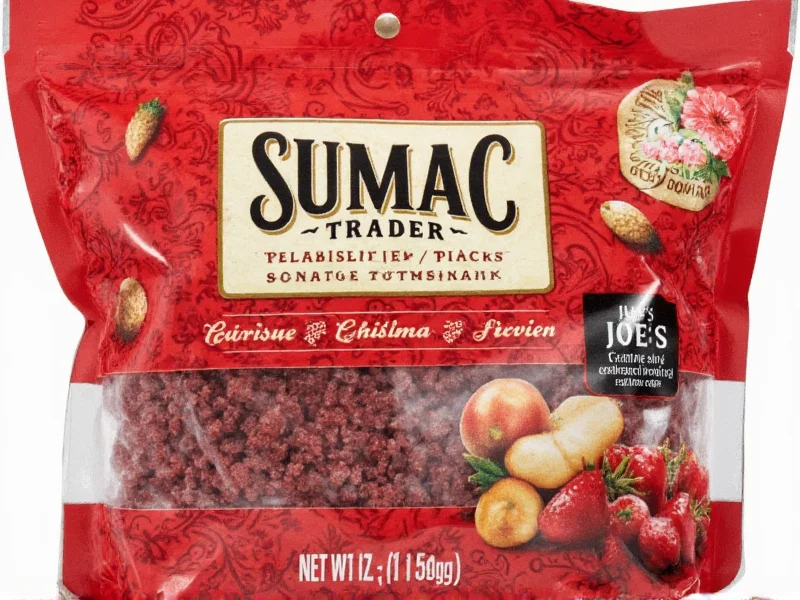Sumac has become increasingly popular in American kitchens as home cooks explore global flavors, and Trader Joe's has responded by offering this distinctive spice in their stores nationwide. Understanding what makes Trader Joe's sumac special requires examining both the product itself and how it fits into contemporary cooking trends.
What Exactly Is Sumac?
Sumac isn't the poisonous plant some Americans might initially think of—it's a completely different species. The culinary variety comes from Rhus coriaria, a shrub native to the Mediterranean region. The deep red berries are dried and ground to create the spice we use in cooking. This spice delivers a distinctive tart, citrus-like flavor without containing any actual citrus.
Unlike many spices that lose potency quickly, sumac maintains its vibrant flavor profile for several months when stored properly. Its unique taste profile makes it versatile across various cuisines, particularly Middle Eastern, Mediterranean, and North African dishes.
Trader Joe's Sumac Product Specifications
When searching for sumac at Trader Joe's, look for the small container typically located in the spice section. The product details include:
| Feature | Details |
|---|---|
| Product Name | Sumac |
| Size | 2.5 ounces (71g) |
| Price | Approximately $3.99 |
| Certification | USDA Organic |
| Origin | Sourced from Mediterranean regions |
| Shelf Life | 1-2 years when stored properly |
How Trader Joe's Sumac Compares to Other Brands
When evaluating sumac options at different stores, several factors distinguish Trader Joe's offering:
- Price point: Trader Joe's sumac typically costs about 30-40% less than specialty store brands while maintaining comparable quality
- Organic certification: Unlike many mainstream grocery store options, Trader Joe's version carries USDA organic certification
- Color intensity: The deep burgundy hue indicates freshness and proper processing
- Flavor profile: Less bitter and more consistently tangy than some supermarket generic brands
Professional chefs who've sampled various sumac brands often note that Trader Joe's strikes an excellent balance between quality and affordability, making it particularly suitable for home cooks exploring Middle Eastern cuisine for the first time.
Culinary Applications for Trader Joe's Sumac
The distinctive flavor profile of sumac makes it incredibly versatile in the kitchen. Here are some of the best ways to use Trader Joe's sumac:
Classic Middle Eastern Dishes
Sumac features prominently in traditional recipes like:
- Fattoush salad (the sumac-lemon dressing defines this Levantine bread salad)
- Mujadara (lentil and rice dish where sumac adds brightness)
- Grilled meats, particularly chicken and lamb
- Manakeesh (Middle Eastern flatbread)
Modern Culinary Innovations
Chefs have expanded sumac's applications to include:
- Roasted vegetable seasoning (especially effective with cauliflower and eggplant)
- Seafood rubs (complements fish beautifully)
- Compound butters (mix with butter, garlic, and herbs)
- Salad dressings (substitute for lemon juice in vinaigrettes)
- Even dessert applications (sprinkled on vanilla ice cream or fruit)
Proper Storage Techniques for Maximum Freshness
To maintain the vibrant flavor and color of Trader Joe's sumac:
- Transfer to an airtight container immediately after opening
- Store in a cool, dark place away from heat sources
- Avoid humidity—consider adding a silica packet to the container
- For extended storage (beyond 6 months), refrigeration helps preserve flavor
- Check color periodically—faded brown indicates diminished quality
Unlike many ground spices that last 1-2 years, sumac's volatile compounds mean it's best used within 6-12 months for optimal flavor. The deep red color will gradually fade as it ages, providing a visual indicator of freshness.
Common Questions About Trader Joe's Sumac
Based on frequent inquiries from home cooks, here are answers to the most common questions about this product:
Where exactly can I find sumac at Trader Joe's?
Look for Trader Joe's sumac in the spice aisle, typically grouped with other Middle Eastern spices like za'atar and baharat. It's usually in a small 2.5-ounce container with a distinctive red label. Some larger stores might also stock it in the international foods section, but the spice aisle remains the most consistent location.
Is Trader Joe's sumac the same as za'atar?
No, Trader Joe's sumac is a single-ingredient spice, while za'atar is a spice blend that typically contains sumac along with thyme, oregano, sesame seeds, and sometimes other ingredients. Sumac provides the distinctive tangy flavor in za'atar, but they are separate products with different flavor profiles and culinary uses.
Can I substitute lemon juice for sumac in recipes?
While both provide tartness, they're not perfect substitutes. Sumac offers a more complex flavor with earthy notes beyond just acidity. If substituting, use about half the amount of lemon juice compared to sumac called for in a recipe, and consider adding a pinch of paprika for color and depth. For authentic Middle Eastern dishes, sumac provides a distinctive flavor that lemon juice alone cannot replicate.
Does Trader Joe's sumac contain any additives or fillers?
No, Trader Joe's sumac is a single-ingredient product with no additives, anti-caking agents, or fillers. The ingredient list simply states "Sumac" and it's certified organic, which prohibits the addition of any non-organic substances. This purity contributes to its vibrant color and clean flavor profile compared to some commercial spice blends that include sumac.
How can I tell if my Trader Joe's sumac has gone bad?
Fresh sumac should have a deep burgundy to reddish-purple color and a pleasant, tangy aroma. If it has turned brownish, lost its vibrant color, or developed a musty smell, it's past its prime. While not dangerous to consume, stale sumac will lack the characteristic tart flavor and may taste flat or bitter. Properly stored in an airtight container away from light and heat, Trader Joe's sumac maintains quality for 6-12 months after opening.











 浙公网安备
33010002000092号
浙公网安备
33010002000092号 浙B2-20120091-4
浙B2-20120091-4